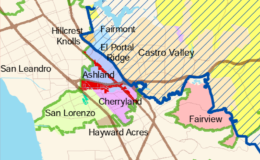I think that surely alameda county must be over estimating the value of Senior Planner time and Secretary II time. Those numbers imply that the secretary is making over $250k/year and the Planner is making roughly $350k. The folks who are up in arms over the CVUSD espresso machine should set their sights on the county instead. Regardless of whether or not the MAC is elected, the MAC doesn’t yield enough power to adequately ensure a voice for CV residents within the county.
The Eight Elected MACs of Stanislaus County
- By : Michael Baldwin
- Category : Governance, Headline Story
- Tags: MAC

One of the goals of the Eden Area Liveability Initiative (EALI) is to “enhance local governance.” To that end, the EALI Governance Working Group has been evaluating alternate methods of local governance in Castro Valley, and the entire Eden area. One scenario being looked at is to change our existing Castro Valley Municipal Advisory Council (MAC) from a body appointed by the Alameda County Board of Supervisors into an elected one.
At the June 26th meeting of the EALI Governance Working Group, Mona Palacios from the Alameda County Local Agency Formation Commission (LAFCO) said that “most counties that had elected MACs, such as Contra Costa County, have moved to appointing them due to increased election costs.” Tim Dupuis, Alameda County Registrar of Voters also noted that “the cost of holding elections has increased due to language and accessibility requirements.”
Palacios also reported that LAFCO had queried other counties in the state as to how they selected their MACs. A list of six counties was presented noting that the majority of MACs were appointed, and some elected ones had been converted to appointed because of cost concerns. Overall, Alameda County staff deems the proposal “economically unfeasible” due to election costs.


One county that was absent from this list is nearby Stanislaus County. This Central Valley county has eight elected MACs, established between 1983 and 2006. They are all five member councils with members serving four year elected terms of office.
- Denair: Population 4404
- Empire: Population 4189
- Hickman: Population 641
- Keyes: Population 5601
- Knights Ferry: Population 98
- Salida: Population 13722
- South Modesto (represents 6 unincorporated pockets in and adjacent to the City of Modesto): Population 1200
- Valley Home: Population 228
As you can see all eight of these communities taken together are half the population of Castro Valley, but they collectively have 40 people elected to advise the County on their behalf. Tiny Knight’s Ferry has five elected MAC members for 98 residents. That’s a ratio of about one member for every 20 residents.
How did this come to be? How can unincorporated Stanislaus County residents continually elect their MAC members without bankrupting the county coffers?
The Stanislaus MACs are basically unfunded. For example, the Salida MAC is unpaid, its members receive no stipend and the MAC has a budget of $150 per year. This is the same for the other seven Stanislaus MACs. Conversely, the Castro Valley MAC members are paid a $50 stipend per meeting, and incurs various other costs for County staff payroll which totals up to $135,912 in a typical year. (see figure.)

As you can see, the lion’s share of Castro Valley MAC costs stem from the Land Use component of their services. Since Stanislaus MACs deal solely General Purpose topics, they do not incur those costs.
The election costs are significantly lower in Stanislaus. According to the Salida MAC, the Registrar in Stanislaus states that it costs $1.10 per registered voter in the area for an election. In the overall MAC areas of Stanislaus, they have 30,083 residents. assuming they have the same percent of registered voters as Castro Valley (56%) , they have about 16,846 registered voters. Therefore, an election involving electing any position in all of the MACs at the same time would only cost $18,530.60. This however has turned out to be very rare. For example, in 2013 there were 21 (out of 40) MAC commission slots up for election. Out of those all 21 slots were either uncontested or left vacant due to lack of candidates. Therefore, Stanislaus incurred zero election expense for their MACs in 2013.
Here in Alameda County, our Registrar has estimated a potential cost per voter of $4 (at the low end.) That means for a MAC election for all of Castro Valley’s 34,904 registered voters it would cost $139,616.
According to Tim Dupuis, Alameda County Registrar of Voters:
“[W]e actually have to translate the materials into 8 different languages in addition to English. These additional languages increase our printing costs. We are required to have voting material available everywhere in our 5 primary languages – English, Spanish, Chinese, Vietnamese and Tagalog. We are also required to have targeted material available in Japanese, Hindi, Khmer and Korean. To support all of these languages, we need bilingual poll workers that can assist voters in the various languages spoken within the community. This increases our poll worker recruitment costs. We need enough recruiters with at least bilingual skills to be able to cover the 9 languages. We need people that can assess potential bilingual poll workers for their ability to speak, write and read fluently in the targeted language as well as English. All of these language support requirements increase Alameda County’s cost per voter above what is being quoted by Stanislaus”
Stanislaus County is not required to translate material into as many languages. Language requirements vary by County and are determined by the California Secretary of State based on census data of the County population.
Despite the potential costs, the Stanislaus Board of Supervisors is currently considering adding a ninth MAC for the small agricultural community of Wood Colony.
In California, there exist other examples of MAC-like bodies functioning well using “informal” election techniques, at no cost to their Counties. We will explore these options and also the applicable election regulations regarding ballot language requirements in future blog posts.


